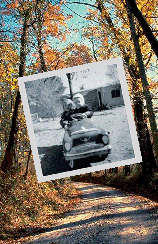Looking down the road
As Baby Boomers approach the golden years, are they ready?
Looking down the road
As Baby Boomers approach the golden years, are they ready?
Children born during the post-World War II “baby boom” have never let themselves be ignored. Their numbers alone — 76 million to 78 million — assure that they will be reckoned with.
 Now these boomers are headed for retirement, and they are expected to have a dramatic effect on U.S. economic and health-care resources.
Now these boomers are headed for retirement, and they are expected to have a dramatic effect on U.S. economic and health-care resources.
“No demographic or social trend has had, or likely will have, a greater impact,” says nursing Associate Professor Charles Walker.
Walker, a gerontology nurse and boomer himself, defines a baby boomer as anyone born between June 1, 1946, and Dec. 31, 1964. The population is subdivided into early boomers and late boomers, with each group sharing experiences.
“Early boomers remember the ‘American Dream,’ ” Walker said. “They lived in a time of political optimism and a thriving economy. Late boomers, however, remember political cynicism, scandals such as Watergate and a strained economy that included waiting in lines for gasoline with their parents.”
Walker has taken a long, scientific look at several concepts regarding boomers’ preparedness for the challenges that come with aging. He calls it their readiness factor.
“Readiness refers to the cognitive and emotional forces that must be in place in order for a person to master a developmental task,” he explained.
As boomers approach the benchmark for retirement (the oldest members of the generation will turn 65 in 2011), Walker’s study lists three criteria for determining their readiness: fearlessly dealing with uncertainty, accepting physical change and doing what’s possible to prepare for the future.
“When it comes to facing uncertainties, young, financially secure, married women are most adept,” he said. “Ethnic minorities, particularly African Americans, are best able to accept physical changes that come with age. Effectively dealing with physical changes involves the ability to unite the youthful self with the aging self.”
Walker believes that women who hold advanced degrees are the boomers most likely to do everything they can to prepare for aging in mid-life. “Research indicates that these individuals place high priority on concerns like nutrition, exercise, taking prescriptions as directed, nurturing relationships and retaining retirement accounts and additional life insurance.”
Men and women approach aging differently. For women, menopause is an undeniable sign that they’re entering a new phase. “This may explain why women are able to be more ready,” Walker said. “They approach aging with a ‘zealous patience’; they’re willing to await the inevitable.”
Men, on the other hand, perceive aging more conceptually, “as an event that will occur in the distant future,” Walker said. But men who live to be 65 or older “experience more feelings of personal efficacy than their female counterparts.”
Overall, he said, research has shown that “chronological age is not a predictor of aging readiness, but gender and ethnicity are.”
Understanding aging readiness should help researchers more accurately predict health outcomes and hopefully help society handle the growing nursing shortage in the next few decades.
“Aging boomers will put a major strain on health-care resources,” he said, “heightening the need for more health-care providers.”

Your comments are welcome
Comments
Related Reading:
Campus News: Alma Matters
From Application to Admission
Amid an increasingly selective admission process, Heath Einstein leads the team that builds the TCU community of the future.
Campus News: Alma Matters
From the Chancellor
Chancellor Victor J. Boschini, Jr., identifies what made TCU and its sesquicentennial so memorable.